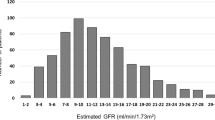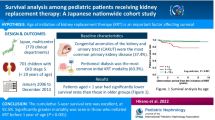Abstract
Background
End-stage renal disease (ESRD) in children is considered a rare, but serious condition. Epidemiological and demographic information on pediatric ESRD patients around the world is important to better understand this disease and to improve patient care. The Japanese Society for Pediatric Nephrology (JSPN) reported epidemiological and demographic data in 1998. Since then, however, there has been no nationwide survey on Japanese children with ESRD.
Methods
The JSPN conducted a cross-sectional nationwide survey in 2012 to update information on the incidence, primary renal disease, initial treatment modalities, and survival in pediatric Japanese patients with ESRD aged less than 20 years during the period 2006–2011.
Results
The average incidence of ESRD was 4.0 per million age-related population. Congenital anomalies of the kidney and urinary tract were the most common cause of ESRD, present in 39.8 % of these patients. In addition, 12.2 % had focal segmental glomerulosclerosis and 5.9 % had glomerulonephritis. Initial treatment modalities in patients who commenced renal replacement therapy (RRT) consisted of peritoneal dialysis, hemodialysis, and pre-emptive transplantation (Tx) in 61.7, 16.0, and 22.3 %, respectively. The Japanese RRT mortality rate was 18.2 deaths per 1000 person-years of observation.
Conclusion
The incidence of ESRD is lower in Japanese children than in children of other high-income countries. Since 1998, notably, there has been a marked increase in pre-emptive Tx as an initial treatment modality for Japanese children with ESRD.



Similar content being viewed by others
References
Schoenmaker NJ, Tromp WF, van der Lee JH, Offringa M, Craig JC, Groothoff JW. Quality and consistency of clinical practice guidelines for the management of children on chronic dialysis. Nephrol Dial Transplant. 2013;28:3052–61.
Andreoli SP, Brewer ED, Watkins S, Fivush B, Powe N, Shevechek J, et al. American Society of Pediatric Nephrology position paper on linking reimbursement to quality of care. J Am Soc Nephrol. 2005;16:2263–5569.
United States Renal Data System (USRDS). Annual data report: atlas of chronic kidney disease and end-stage renal disease in the United States. http://www.usrds.org/adr.aspx 2014. Accessed 17 Sept 2014.
North American Pediatric Renal Transplant Cooperative Study (NAPTCS). http://spitfire.emmes.com/study/ped/index.htm 2014. Accessed 17 Sept 2014.
van der Heijden BJ, Van Dijk PCW, Verrier-Jones K, Jager KJ, Briggs JD. Renal replacement therapy in children: data from 12 registries in Europe. Pediatr Nephrol. 2004;19:213–21.
Tizard EJ, Verrina E, van Stralen KJ, Jager KJ. Progress with the European Society for Paediatric Nephrology (ESPN)/ERA-EDTA Registry for children with established renal failure (ERF). Nephrol Dial Transplant. 2009;24:2615–7.
van Stralen KJ, Tizard EJ, Verrina E, Schaefer F, Jager KJ, European Society for Paediatric Nephrology/European Renal Association-European Dialysis and Transplant Association (ESPN/ERA-EDTA) Registry Study Group. Demographics of paediatric renal replacement therapy in Europe: 2007 annual report of the ESPN/ERA-EDTA registry. Pediatr Nephrol. 2010;25:1379–82.
European Society for Paediatric Nephrology (ESPN) and the European Renal Association and European Dialysis and Transplantation Association (ERA-EDTA) Registry. http://www.espn-reg.org/ 2014. Accessed 17 Sept 2014.
McDonald SP, Craig JC, Australian and New Zealand Paediatric Nephrology Association. Long-term survival of children with end-stage renal disease. N Engl J Med. 2004;350:2654–62.
Orr NI, McDonald SP, McTaggert S, Henning P, Craig JC. Frequency, etiology and treatment of childhood end-stage kidney disease in Australia and New Zealand. Pediatr Nephrol. 2009;24:1719–26.
Hattori S, Yoshioka K, Honda M, Ito H, Japanese Society for Pediatric Nephrology. The 1998 report of the Japanese National Registry data on pediatric end-stage renal disease patients. Pediatr Nephrol. 2002;17:456–61.
Warady BA, Chadha V. Chronic kidney disease in children: the global perspective. Pediatr Nephrol. 2007;22:1999–2009.
Harambat J, van Stralen KJ, Kim JJ, Tizard EJ. Epidemiology of chronic kidney disease in children. Pediatr Nephrol. 2012;27:363–73.
Statistics Japan. http://www.stat.go.jp/index.htm. Accessed 24 Aug 2014.
Mitsnefes MM, Laskin BL, Dahhou M, Zhang X, Foster BJ. Mortality risk among children initially treated with dialysis for end-stage kidney disease, 1990–2010. JAMA. 2013;309:1921–9.
Yamagata K, Yagisawa T, Nakai S, Nakayama M, Imai E, Hattori M, et al. Prevalence and incidence of chronic kidney disease stage G5 in Japan. Clin Exp Nephrol. doi:10.1007/s10157-014-0978-x.
Schaefer F, Borzych-Duzalka D, Azocar M, Munarriz RL, Sever L, Aksu N, et al. IPPN Investigators. Impact of global economic disparities on practices and outcomes of chronic peritoneal dialysis in children: insight from the International Pediatric Peritoneal Dialysis Network Registry. Perit Dial Int. 2012;32:399–409.
Bock ME, Cohn RA. Pre-emptive kidney transplantation—just do it!! Pediatr Transplant. 2010;14:561–4.
Yamada A, Tashiro A, Hiraiwa T, Komatsu T, Kinukawa T, Ueda N. Long-term outcome of pediatric renal transplantation: a single center study in Japan. Pediatr Transplant. 2014;18:453–62.
Borzych D, Ree L, Ha IS, Chua A, Valles PG, Lipka M, International Pediatric PD Network (IPPN), et al. The bone and mineral disorder of children undergoing chronic peritoneal dialysis. Kidney Int. 2012;78:1295–304.
van Stralen KJ, Borzych-Duzalka D, Hataya H, Kennedy SE, Jager KJ, Verrina E, ESPN/ERA-EDTA registry, IPPN registry, ANZDATA registry, Japanese RRT registry, et al. Survival and clinical outcomes of children starting renal replacement therapy in the neonatal period. Kidney Int. 2014;86:168–74.
Acknowledgments
The JSPN ESRD Survey is funded by the Japanese Society for Pediatric Nephrology (JSPN). The authors thank all patients, families, physicians, and institutes who contributed to the JSPN ESRD Survey. The authors also thank Drs. Yuko Akioka, Kenji Ishikura, and Yuko Hamazaki for being members of the JSPN ESRD Survey Committee, and Drs. Shuich Ito, Osamu Uemura, Yoshihiko Ueda, Satoshi Sasaki, Ken Hatae, Hiroshi Hataya, Misako Hiramatsu, Mikiya Fujieda, and Hiroshi Yoshimura and the members of the JSPN, the Japanese Society for Dialysis Therapy (JSDT), and the Japanese Society for Clinical Renal Transplantation (JSCRT) for their contributions to data collection. The authors also thank Prof. Yasuo Ohashi, Mr. Masayuki Kurihara, and Ms. Chie Matsuda of the Japan Clinical Research Support Unit (Tokyo) for their help with data management.
Conflict of interest
The authors have declared that no conflict of interest exists.
Author information
Authors and Affiliations
Corresponding author
Additional information
On behalf of the Japanese Society for Pediatric Nephrology.
About this article
Cite this article
Hattori, M., Sako, M., Kaneko, T. et al. End-stage renal disease in Japanese children: a nationwide survey during 2006–2011. Clin Exp Nephrol 19, 933–938 (2015). https://doi.org/10.1007/s10157-014-1077-8
Received:
Accepted:
Published:
Issue Date:
DOI: https://doi.org/10.1007/s10157-014-1077-8




